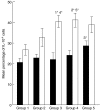Effect of Fusobacterium nucleatum on the T and B cell responses to Porphyromonas gingivalis in a mouse model
- PMID: 11985513
- PMCID: PMC1906396
- DOI: 10.1046/j.1365-2249.2002.01852.x
Effect of Fusobacterium nucleatum on the T and B cell responses to Porphyromonas gingivalis in a mouse model
Abstract
T cell cytokine profiles and specific serum antibody levels in five groups of BALB/c mice immunized with saline alone, viable Fusobacterium nucleatum ATCC 25586, viable Porphyromonas gingivalis ATCC 33277, F. nucleatum followed by P. gingivalis and P. gingivalis followed by F. nucleatum were determined. Splenic CD4 and CD8 cells were examined for intracytoplasmic interleukin (IL)-4, interferon (IFN)-gamma and IL-10 by dual colour flow cytometry and the levels of serum anti-F. nucleatum and anti-P. gingivalis antibodies determined by an ELISA. Both Th1 and Th2 responses were demonstrated by all groups, and while there were slightly lower percentages of cytokine positive T cells in mice injected with F. nucleatum alone compared with the other groups immunized with bacteria, F. nucleatum had no effect on the T cell production of cytokines induced by P. gingivalis in the two groups immunized with both organisms. However, the percentages of cytokine positive CD8 cells were generally significantly higher than those of the CD4 cells. Mice immunized with F. nucleatum alone had high levels of serum anti-F. nucleatum antibodies with very low levels of P. gingivalis antibodies, whereas mice injected with P. gingivalis alone produced anti-P. gingivalis antibodies predominantly. Although the levels of anti-F. nucleatum antibodies in mice injected with F. nucleatum followed by P. gingivalis were the same as in mice immunized with F. nucleatum alone, antibody levels to P. gingivalis were very low. In contrast, mice injected with P. gingivalis followed by F. nucleatum produced equal levels of both anti-P. gingivalis and anti-F. nucleatum antibodies, although at lower levels than the other three groups immunized with bacteria, respectively. Anti-Actinobacillus actinomycetemcomitans, Bacteroides forsythus and Prevotella intermedia serum antibody levels were also determined and found to be negligible. In conclusion, F. nucleatum immunization does not affect the splenic T cell cytokine response to P. gingivalis. However, F. nucleatum immunization prior to that of P. gingivalis almost completely inhibited the production of anti-P. gingivalis antibodies while P. gingivalis injection before F. nucleatum demonstrated a partial inhibitory effect by P. gingivalis on antibody production to F. nucleatum. The significance of these results with respect to human periodontal disease is difficult to determine. However, they may explain in part differing responses to P. gingivalis in different individuals who may or may not have had prior exposure to F. nucleatum. Finally, the results suggested that P. gingivalis and F. nucleatum do not induce the production of cross-reactive antibodies to other oral microorganisms.
Figures




 , Aa;
, Aa;  , Bf;
, Bf;  , Pi.
, Pi.Similar articles
-
Polarization of Porphyromonas gingivalis-specific helper T-cell subsets by prior immunization with Fusobacterium nucleatum.Oral Microbiol Immunol. 2000 Jun;15(3):181-7. doi: 10.1034/j.1399-302x.2000.150306.x. Oral Microbiol Immunol. 2000. PMID: 11154401
-
Modulation of the antibody response by Porphyromonas gingivalis and Fusobacterium nucleatum in a mouse model.Oral Microbiol Immunol. 2004 Aug;19(4):247-51. doi: 10.1111/j.1399-302X.2004.00147.x. Oral Microbiol Immunol. 2004. PMID: 15209995
-
Prior exposure of mice to Fusobacterium nucleatum modulates host response to Porphyromonas gingivalis.Oral Microbiol Immunol. 2001 Dec;16(6):338-44. doi: 10.1034/j.1399-302x.2001.160604.x. Oral Microbiol Immunol. 2001. PMID: 11737656
-
Immunological Pathways Triggered by Porphyromonas gingivalis and Fusobacterium nucleatum: Therapeutic Possibilities?Mediators Inflamm. 2019 Jun 24;2019:7241312. doi: 10.1155/2019/7241312. eCollection 2019. Mediators Inflamm. 2019. PMID: 31341421 Free PMC article. Review.
-
Association of Fusobacterium nucleatum with immunity and molecular alterations in colorectal cancer.World J Gastroenterol. 2016 Jan 14;22(2):557-66. doi: 10.3748/wjg.v22.i2.557. World J Gastroenterol. 2016. PMID: 26811607 Free PMC article. Review.
Cited by
-
Porphyromonas gingivalis and Treponema denticola exhibit metabolic symbioses.PLoS Pathog. 2014 Mar 6;10(3):e1003955. doi: 10.1371/journal.ppat.1003955. eCollection 2014 Mar. PLoS Pathog. 2014. PMID: 24603978 Free PMC article.
-
Cardiovascular disease and the role of oral bacteria.J Oral Microbiol. 2010 Dec 21;2. doi: 10.3402/jom.v2i0.5781. J Oral Microbiol. 2010. PMID: 21523220 Free PMC article.
-
Host and bacterial factors linking periodontitis and rheumatoid arthritis.Front Immunol. 2022 Aug 25;13:980805. doi: 10.3389/fimmu.2022.980805. eCollection 2022. Front Immunol. 2022. PMID: 36091038 Free PMC article. Review.
-
Evaluation of antibody level against Fusobacterium nucleatum in the serological diagnosis of colorectal cancer.Sci Rep. 2016 Sep 28;6:33440. doi: 10.1038/srep33440. Sci Rep. 2016. PMID: 27678333 Free PMC article.
-
Fusobacterium nucleatum and Tannerella forsythia induce synergistic alveolar bone loss in a mouse periodontitis model.Infect Immun. 2012 Jul;80(7):2436-43. doi: 10.1128/IAI.06276-11. Epub 2012 Apr 30. Infect Immun. 2012. PMID: 22547549 Free PMC article.
References
-
- Page RC, Offenbacher S, Schroeder HE, Seymour GJ, Kornman KS. Advances in the pathogenesis of periodontitis: summary of developments, clinical implication and future directions. Periodontology. 2000;14:216–48. - PubMed
-
- Zambon JJ. Periodontal diseases: microbial factors. Ann Periodontol. 1996;1:879–925. - PubMed
-
- Hamlet SM, Cullinan MP, Westerman B, et al. Distribution of Actinobacillus actinomycetemcomitans Porphyromonas gingivalis and Prevotella intermedia in an Australian population. J Clin Periodontol. 2001;28:1163–71. 10.1034/j.1600-051x.2001.281212.x. - DOI - PubMed
-
- Slots J, Ting M. Actinobacillus actinomycetemcomitans and. Porphyromonas gingivalis in human periodontal disease: occurrence and treatment. Periodontology. 2000;1999:2082–121. - PubMed
-
- Holt SC, Kesavalu L, Walker S, Genco CA. Virulence factors of Porphyromonas gingivalis. Periodontology. 2000;1999:20168–238. - PubMed
MeSH terms
Substances
LinkOut - more resources
Full Text Sources
Molecular Biology Databases
Research Materials

